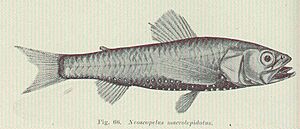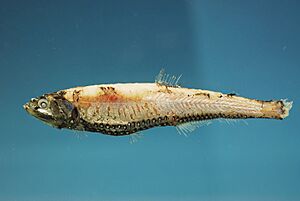Neoscopelus macrolepidotus facts for kids
Quick facts for kids Neoscopelus macrolepidotus |
|
|---|---|
 |
|
 |
|
| Scientific classification | |
| Genus: |
Neoscopelus
|
| Species: |
macrolepidotus
|
The Neoscopelus macrolepidotus, also known as the large-scaled lanternfish, is a small fish that lives deep in the ocean. It belongs to a family called Neoscopelidae, which has six different species. This fish is special because it has amazing light-producing organs called photophores. These organs help it glow in the dark ocean!
This lanternfish usually has a dark grey belly and a silver-grey head. Its fins are a pretty pinkish-red. You can see rows of its glowing photophores along its belly and even on the sides of its tongue. These lights are created through a process called bioluminescence, where living things make their own light. The large-scaled lanternfish doesn't grow very big, usually less than 25 centimeters (about 10 inches) long. You can find it in marine environments all over the world, including parts of the Atlantic, Indian, and Pacific Oceans.
Where the Large-Scaled Lanternfish Lives
The large-scaled lanternfish was first discovered in 1863 by an English scientist named James Yate Johnson. He found it near Madeira, which is a group of islands southwest of Portugal. After that first discovery, scientists found this fish in many different oceans around the world.
Most of these fish live in warm, tropical, and subtropical areas. They usually stay at depths between 300 and 1100 meters (about 980 to 3,600 feet). This deep part of the ocean is called the mesopelagic zone, or the "twilight zone." Some sunlight can still reach this area, but it's very dim. Because there's some light, bigger predators can see them, especially during the day.
How the Lanternfish Survives
Life in the deep, dim ocean is tough! Fish like the large-scaled lanternfish have special ways to survive. They use their senses, like sight and smell, to find their way around and stay safe.
For example, the large-scaled lanternfish has very big eyes. These large eyes help it see better in the dim light. They can pick up faint light from above or the glow from other creatures. This fish also has a large mouth with a jaw that can open wide. This helps it catch food.
Scientists don't know everything about what these fish eat. However, many deep-sea creatures do something called "diel vertical migration." This means they swim up closer to the surface at night to feed on smaller organisms like zooplankton. Then, they swim back down to deeper, darker waters during the day. This helps them hide from bigger predators that might be hunting in brighter waters. Since the large-scaled lanternfish has rows of small teeth, it can also eat other small fish or tiny crustaceans.
Its Special Lights: Bioluminescence
As we mentioned, the large-scaled lanternfish has special organs called photophores that make light. At first, scientists only knew about the lights on its belly. But then, a study by Seishi Kuwabara found photophores on the tongues of this fish and another similar species, Neoscopelus microchir.
The lights on the fish's belly are probably used for something called "ventral counter-illumination." This is a clever way of camouflaging themselves. The fish matches the dim light coming from above. This makes its silhouette disappear, so predators swimming below can't see it easily. It's especially important for this fish because its belly is darker, which would normally make it stand out against the light from above.
Scientists aren't sure why the fish has lights on its tongue. It might help them find food or recognize other lanternfish in the dark deep sea. The fish makes its own light from inside its body. It doesn't rely on tiny glowing bacteria, like some other sea creatures do.

